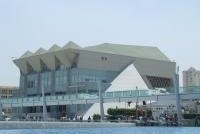
Alexandria's long and colourful history is what makes it such an interesting and diverse city. The remains from the Greco-Roman era are quite evident in the underground necropolises, the Roman theatre and nearby excavations, and artifacts brought from beneath the harbour also on display. The plan of the city was changed radically by an earthquake which toppled the Pharos lighthouse and submerged much of the city creating the harbour. The Ottomans used the stone from the lighthouse to build much of the Qait Bey citadel. Modern architecture is represented by the palaces built for King Farouk in the Montazah Gardens and the ultra-modern library complex completed in 2002.
Keep reading 0 comments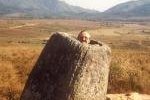
Spent two days in Wudalianchi last October 2010.
It is amazing to learn about the preparations the local government are doing for the WHS Convention next year. Along with Hangzhou West Lake, this wonderful place is China's bid for 2011 world heritage site.
I found out from the locals that a new airport is being constructed in this small city. A train station is also being built. Most travel books recommend taking transportation from Harbin (Heilongjiang Province capital) or Qiqihar or Daqing to get to Beian - the closest city to the scenic spots of Wudalianchi. Transportation from any of these three cities to Beian takes 4-5 hours; and then another hour from Beian station to the park itself. Hence, I can say that the distance of the park can be a hindrance to lure tourists.
But that said, the place is definitely worth the visit. IMHO, I also think it will best "represent" a Heilongjiang World Heritage Site, instead of the proposed germ warfare site in Harbin.
A guy from the local tourism bureau said that there are multiple areas being considered for inscription. I got to visit three: Longmen Stone Village, Laohei Volcano and Wenbo Volcanic Spring.
Keep reading 0 comments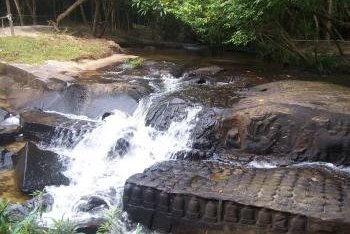
I visited the site of Kbal Spean, or the River of 1,000 Lingas which is included in this batch of monuments. It was a really rewarding place to visit as one of the outlying Angkorian monuments and made a great morning trip when combined with the magnificent Banteay Srei temple.
Here the river bed is carved with multiple representations of lingas and yonis as well as several other carvings on the river banks. These were used to symbolically purify the water flowing into the central temple complex of Angkor. It is a pretty impressive spectacle and the carvings continue for about 100m downstream of the first batch at the top of a waterfall.
It takes a little while to get out to the site from Siam Reap, and once at the site there is a 1,5km walk from the car park. It is a pretty nice walk, although some bits are a little tough as you clamber over rocks.
I guess if this was ever added to the list it would be as an extension to the WHS of Angkor, however if any site on the world heritage list deserves to be inscribed twice it is Angkor. So I would fully support it being added separately.
[Site 7 Experience 7]
Keep reading 0 commentsAnonymous
Village souterrain d'Agongointo-Zoungoudo
Village souterrain d'Agongointo-Zoungoudo (On tentative list)
This is an amazing site of over 150 caves used during kindgom battles of over 400 years ago in the Abomey region of Benin. The tour guides are excellent and the site is set up so one can visit the interior of once cave fully in tact as well as climb down into the cave that was first identified when a bulldozer fell into it just a few years ago during road construction.
The grounds are lovely and include fantastic local huts, a playground for kids, and a gorgeous butterfly garden.
A great visit and right off the national road between Cotonou and Parakou at Bohicon.
Keep reading 0 comments
This monastery was well worth a visit. I discovered that certain buses operating between Tarragona and Lleida detour via the entrance to the monastery, and that it was possible to make an afternoon visit from Tarragona that way.
Keep reading 0 comments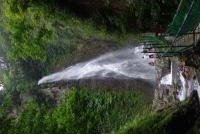
As to how to see and what you can see at the site in Arras, all you have to do is to try to take paths around the fort that are closest to the fort. Well, you can hardly see the inside of the fort, but you can see the outside, and this is all you can see there. These paths are also created for hiking and biking. One can actually walk around the fort and see the fort at various points along the way.
Also remind you that Arras' belfry is also inscribed in the WH list.
So Arras has TWO WHSs!
Keep reading 0 comments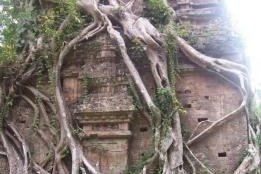
This is the best preserved pre-Angkorian archaeological site in Cambodia and if all goes to plan then this should be Cambodia's next World Heritage Site.
The ruins here comprise three different temple complexes all within easy walking distance of each other. They are set among a nice sandy forest that gives the site a cool and relaxing atmosphere. The ruins are different enough from those at Angkor to warrant a visit and also provide a good look at pre-Angkorian styles or art and architecture. The temples are mostly brick built and look more like hollow pyramids, the distinctive poses of the statues of this period are shown in reproductions as the originals are now in museums. There is also a fair bit of bomb damage to some of the temples, from the US bombing raids and also from the civil war. There are also several temples that have been completely taken over by trees, the gatehouse at the final complex is now more tree than brick.
The site is located to the north of Kompong Thom. I managed to visit in a short day trip from Siem Reap. It was very easy to get a moto from the junction just before Kompong Thom out to the site and to bring me back. The route out there was very enjoyable, going through some nice villages and between some lovely paddy fields.
The temples here were sufficiently different from those at Angkor to warrant a visit. There is a nice ambiance to …
Keep reading 0 comments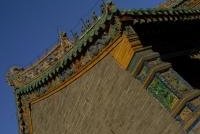
The Shenyang Imperial Palace may not be as grand as its Beijing counterpart; however, what makes up for its size is the intricate design of the buildings. The Manchu style of architecture is not like any other seen in most temples or buildings in China.
I stayed in Shenyang for two days and got to visit the other two Qing dynasty tombs in the city - Zhaoling and Fuling.
Keep reading 0 comments
Le Morne is easy to see but hard to visit. I had my first look at it from the plane arriving from Paris. On the descent, this remarkably shaped mountain at the tip of Mauritius was very clearly visible. Its inaccessibility of course is part of its history. The steep cliffs deterred many. Mauritius even stated at the nomination of this site for WHS that the absence of cultural evidence is the ultimate proof of maroon life, as they had to be as invisible as possible. That's a daring statement for a 2034-page-long nomination file!
Few traces remain: six rock shelters used by maroons have been discovered on the summit, and a network of trails used by the former slaves is also still there. Fishing for your own meal is a common pastime too in the modern Le Morne village like it was during slavery. But there's nothing specific to see for the casual visitor. I started out on foot from Le Morne, and walked on the beach onto the thin isthmus that separates Le Morne from the Mauritian mainland. At that spot, there's a sign that you enter the WHS area.
Le Morne Village nowadays is a sleepy town, where people surf and fish. Like other villages in the area, it is mostly inhabited by Creoles, and as such has a less Indian feel than the rest of the island. The taxi driver that had taken me there made the best out of our visit and bought …
Keep reading 0 comments
Aapravasi Ghat is right in the center of Port Louis, the capital of Mauritius. The site is signposted from all over town, displaying its WH status proudly.
From the outside the complex looks like the remains of a fortress: not unlike those in Ghana, or even the Defense Line of Amsterdam in The Netherlands. It’s now located just a few meters from the water line in the harbour.
Entrance to the site is free, as is the guided tour. The first thing that I noticed is that it all looks very recently restored. I had heard bad reports about its status in the past, but right now the Aapravasi Ghat Trust Fund is taking things seriously. Even a whole new interpretative center is under construction at the moment. That would be a good addition I think, as the remains of the site are small and it’s hard to imagine what happened here from some crumbling stone walls. Archaeological digs are still underway too, in the hope of recovering more. Only about a third of the site is left now, the rest has been paved over during the construction of the main road through Port Louis.
The best-preserved parts are the lavatories & baths for the immigrants and the small hospital. I went around with a guide once and after that did another round on my own. I knew beforehand that there isn’t much to see, and I already was glad to see that the caretakers are making …
Keep reading 0 comments
After the big shake of 1755, the new buildings incorporated a set of features intended to supply them with adequate seismic behavior, enabling them to resist horizontal loads and to dissipate a considerable amount of energy. Among these measures the so -called �Gaiola� (the Cage) stands out , unquestionably Gaiola is based on a set of timber members embedded along the inner face of the main stone masonry facade walls.
�Baixa Pombalina �allow us to interpret an outstanding anti-seismic construction system, which was a step beyond its time.
Today it still reveals high efficiency.
Keep reading 0 comments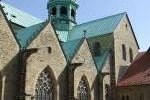
Externally these two monumental buildings have architectual merit, and the restoration of St Michael's church has been completed. The interior of that building is pristine, and is now restored to its original condition. The Dom on the other hand is now undergoing restoration and will be closed until 2014. So I was only able to access the cloister and its garden. But I did see the bronze doors.
Keep reading 0 comments
We absolutely marveled at Joya de Ceren! It truly is a jewel and must not be missed when traveling in El Salvador. My husband is Salvadoran and American and he was so proud of his country and what they have uncovered. The museum was fantastic, the tour informative, and the landscaping meticulous.
I blogged our visit plus a bunch of pictures, which do not do justice what you see in real life. aut2bhomeincarolina.blogspot.com/2010/10/joya-de-ceren-archaeological-site.html
Keep reading 0 comments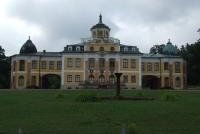
Weimar impressed me on arrival. As I emerged from the railway station the classical stone architecture gave a feeling of style and permanence. The mood only improved as I reached the the town centre. Beyond the centre there are so many other interesting buildings to see: the royal tomb and its Russian church, the Roman House and Goethe's garden house in the park beside the river Ilm. Then the local buses took me further out, to the Belvedere palace, Tiefurt Palace and the Ettersburg Palace, as well as to the site of the infamous Buchenwald concentration camp.
Weimar deserved three days to explore it fully, and to take a trip to nearby Wartburg castle in Eisenach
Keep reading 0 comments
I managed to visit only 3 of the gardens. It was an ultimate aesthetic experience- the pools and pavilions, lotus and lilies, koi and cicadas, bamboo and pine, Taihu rocks and paved tiles......I could only imagine how pleasant it might have been minus the milling crowds!
I wish I knew Chinese to fully appreciate the poetry.
Keep reading 0 comments
I visited in September 2010 in two of the churches in Moldovita and Sucevita monasteries. Like the other review says Sucevita was big and very well maintained but somehow I liked Moldovita more. The paintings were in much better conditition in Sucevita but atmosphere in the smaller and less touristic Moldovita was much nicer (maybe because the nuns in Sucevita were little rude). But the amazing paintings of these churches are definitely worth of seeing, they're full of little details.
Keep reading 0 comments
Compared to the drab dilapidated post-war housing estates of Britain I found these housing estates in Berlin well maintained and architecturally inspired. In the course of a day, and using the U and S-bahns and the buses I reached all the locations listed. I found the pastel coloured terraced houses at Falkenburg the most attractive.
Keep reading 0 comments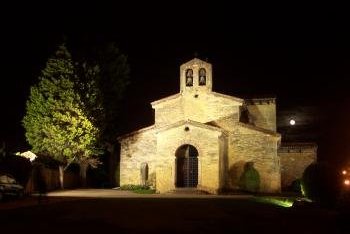
At the start of my trip around northern Spain I based myself in Oviedo, to enable me to see a bit of Asturian countryside and also the bulk of the sites in this inscription.
My first stop was to walk up to the sites at Monte Naranco overlooking the city. I was surprised by how small the monuments actually were; there was not a huge amount of room especially inside San Miguel de Lillo. The architecture was impressive in an understated, almost crude kind of way, and there were lovely sculpted detailing in the former palace of Santa Maria. The two sites were surrounded by nice green pastures and afforded wonderful views over Oviedo, especially down to Santiago Calatrava’s striking new conference centre. They are about 3km west of the station and uphill, it took me about 35 minutes to walk there from the station but Bus 10 is probably a better option for those that don’t fancy a bit of a hike. When I visited tours were given in Spanish, but I found it fairly easy to understand the gist as I had done a bit of background reading.
I walked back down into the city, accompanied by the sound of clunking cowbells in the nearby pastures and bagpipes at a local wedding. I didn’t make it down in time to see any of the interiors of the inscribed sites but did enjoy walking around and people watching on the streets of the charming old town. The Camara Santa …
Keep reading 0 comments
very disappointing that so little of the site is currently open.They only seem to be working on one building at present yet have ripped out the walkways and closed most of the site much earlier than necessary.With a little planning they could easily work in stages and keep most of the site open.What you can see is fantastic but its very frustrating to see tantalizing distant glimpses of so much more in the closed areas.I will return one day when its fully open but unless they get their act together I suspect this may be years away.
Keep reading 0 comments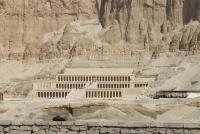
The temples of Luxor and Karnak on the west bank and the Temple of Hatshepsut on the east bank of the Nile are simply amazing for the amount of work and effort that was expended creating them. Today, even with cranes and other machinery it would be difficult, but 5000 years ago it was all done by human power. And then followed all the work of painstakingly carving the designs and hyroglyphs. The effort surely dwarfs any construction project of the modern era.
Keep reading 0 comments